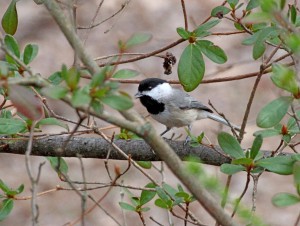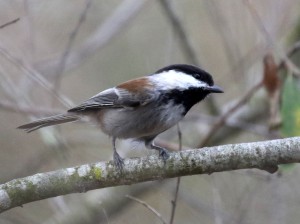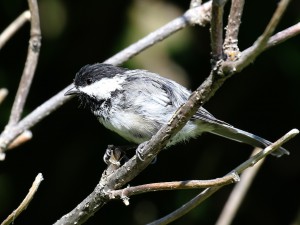
This Black-capped Chickadee was a regular visitor to the yard of the guest house where we were staying.
Seven chickadee species regularly occur in North America: Carolina, Black-capped, Boreal, Mountain, Chestnut-backed, Mexican and Gray-headed Chickadee. Chickadees form a closely-related group, all belonging to the same genus (Poecile). Chickadees are members of the family Paridae, which also includes the titmice. European birders call chickadees “tits”, and tits include some of the largest and most colorful members of the family.
Chickadees are small birds with big personalities. Chickadees get their name from their songs, which sound as though they are saying “chick-a-dee-dee-dee”, or variations on that theme. They are small birds (the largest are just 5.5 inches long) with proportionately large, round heads, variable amounts of white in prominent cheek patches, and always a black throat. All of our chickadees have short, sharp bills well-adapted for hammering open seeds or grabbing bugs out of crevices. Chickadees are gregarious, flocking birds except when nesting and fledging young each year. Then the flocks break apart and birds set up breeding territories. Chickadees frequently visit bird feeders across the continent, making them some of North America’s best known and most beloved birds.
Identification
You can’t mistake many birds for a chickadee, with the possible exception of the Black-throated Gray Warbler. The warbler’s black throat, crown and (“ear patch”) and it’s bright white supercilium (eyebrow), recall features of a Mountain Chickadee, with which its range does overlap. But the more slender and elongated warbler feeds on insects and shows prominent yellow in the lores as well as heavy black streaking along the breast. Whereas the shorter, stockier and more round-headed chickadee eats seeds with shows bright white cheeks.
So really, the only identification difficulties that chickadees present is with other chickadees. This is greatly simplified by the fact that some of them simply don’t overlap with any others in range. For example, the Gray-headed Chickadee inhabits only the upper slopes of central and northern Alaska and northwestern Canada, where it overlaps only with Black-capped Chickadee. But it is browner on the crown and nape, where the Black-capped is completely black.
The Mexican Chickadee might be problematic, except its only occurrence in North America is in the Chiricauhua Mountains of extreme southeastern Arizona and in the Animas Mountains of southwestern New Mexico. The only other chickadee that might overlap with it is the Mountain Chickadee. Mexican Chickadee differs from all other North American chickadees in that it has grayish rather than buffy or whitish flanks, and it has the most extensive black bib or throat patch of any chickadee. Mountain Chickadee is unique in having the white supercilium and they have large, bright white auriculars as mentioned above.
The Difficult Pair
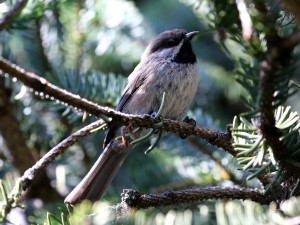
This Boreal Chickadee was one of a flock of 7 that investigated pishing at a Nature Center above Homer, AK.
Separating Carolina from Black-capped Chickadee is challenging. Those two species overlap in Maryland, Delaware, southeastern Pennsylvania and possibly southern Ohio. The best way to separate these species by plumage lies in the folded wing feathers. The Carolina Chickadee has completely gray wing feathers with pale edging, whereas the Black-capped Chickadee has a linear patch of white-edged wing feathers that shows up as almost a white stripe in the folded wing. The other really excellent way to distinguish between those two is by songs and calls (see below).
Range
Black-capped Chickadee has the most extensive range of all North American Chickadees, from Alaska to Newfoundland and from northern California all the way across to Maryland. Carolina Chickadee takes over immediately to the south, ranging from central and coastal Texas all across the Gulf states to northern Florida, and north as far as southeastern Kansas, across to southeastern Pennsylvania and Delaware. The rest of the chickadees are not difficult to distinguish.
Boreal Chickadee range all across Canada and most of Alaska, dipping down into the northernmost of the lower 48 states. This chickadee is unique in having a rich brown crown, along with a paler brown back and reddish-brown color on the flanks. It is unique among the North American chickadees in having a grayish shading to the white ear patches. Chestnut-backed Chickadee uniquely combines a bright reddish back with the full black cap and bib. One only finds Chestnut-backed Chickadee in the wetter forested west coast from central California north to the Kenai Peninsula in south coastal Alaska.
Mountain Chickadee is a bird of the high west, with its range following the mountains from south central Yukon through British Columbia down into eastern Washington, Idaho and western Montana and following the Rockies and the Sierra, branching to follow the coastal ranges in Washington, Oregon and northern California, and down through western Wyoming, Utah, Colorado and northern Arizona and northeastern New Mexico. Interestingly, the isolated population in the coastal ranges of southern California colonized extensive parts of the coastal plain here in Orange County, California relatively recently. Isolated populations like this often harbor unique genetic uniqueness to varying degrees, so watch this one closely, if you have a few thousand years at your disposal, that is!
Vocalizations
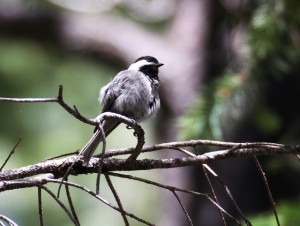
This Mexican Chickadee responded to pishing in Rustler Park, at the top of the Chiricauhua Mountains in southeastern Arizona.
One of the best ways to identify chickadees in the field is by their vocalizations. Black-capped Chickadees have the familiar chick-a-dee-dee-dee call, and a pure whistled feebee song, as well as some sharp chik notes. Carolina Chickadees call with a much more rapid chickadeedeedeedee and often sing a 4-note see-bee see-bay song. Written out, these may look like they sound the same, but in the field, they are actually quite distinctive. Mountain Chickadees sing a rapid buzzy variant sounds like chicka-dzee-dzee. They call with a descending of 3-6 notes fee-bee-dee-dee. Mountain Chickadee song varies tremendously across its range. Mexican Chickadee sounds almost titmouse-like, with a peeta-peeta-peeta call and a slow tzee-tzee-tzee shhh shhh song.
Chestnut-backed Chickadee doesn’t even have the typical whistled song; their call is nasal and buzzy in tone, like tsidi-tsidi-tsidi-cheer-cheer. The accelerated series of chips may serve as a their song. Boreal Chickadee has a simple clear trill for a song with a short first note: p-twee-tititititititititi. The call is a wheezy tzi-jaaay or tzi-si-jaaay. No one knows what the Gray-headed Chickadee’s song sounds like! It may use short whistled notes or phrases as a song. They call with a buzzy tsiti-ti-ti-jeew jeew jeew, drawing the latter notes out. Basically, all chickadee songs and calls seem like variations on common themes, but all are distinctive enough to use for identification purposes.
Breeding
Black-capped, Carolina, Mexican and Mountain chickadees practice monogamy. The mate fidelity of Chestnut-backed, Boreal and Gray-headed Chickadees is unknown. All chickadees are cavity-nesters, using pre-existing cavities or enlarging holes in a softer, decaying part of the tree. It may require 10-14 days to excavate and line the nest cavity, with both males and females cooperating at it. After excavation, the birds line the nest with plant down, feathers, moss, hair or insect cocoons.
Chickadees nests usually occur in a pre-existing snag or dead tree, although this can vary with the availability of cavities. Chickadees average on the order of 5-8 eggs per nest. Both genders incubate the eggs, which typically hatch after about 10-15 days of incubation (this varies a bit between species). Baby chickadees are altricial, meaning they are born blind, without down and essentially are immobile at first, and require feeding by the parents. Both males and females cooperate to feed the chicks. Young chickadees typically fledge in about 13-18 days; fledglings will remain with the parents for about three weeks before family groups disperse. Though chickadee species pairs overlap in multiple regions, only Black-capped and Carolina Chickadees hybridize with each other.
Feeding and Other Behaviors
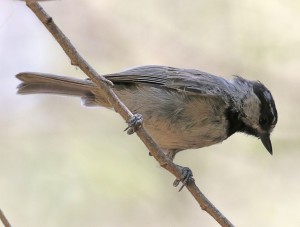
Mountain Chickadees are increasingly common residents on the coastal plain in Orange County, California.
Except for breeding, chickadees are gregarious birds, and they spend much of their lives in flocks, either with other chickadees or mixed with other passerines like titmice, nuthatches, kinglets, creepers, warblers and woodpeckers, particularly in winter. When chickadees encounter a predator, they will often engage in very vocal and hyperactive mobbing behavior, in which they scold the offending bird and draw attention to its presence, hoping to drive it off. They also typically respond strongly to pishing in the field, which can provide an observer with great looks at them, although care should be taken not to overuse this. In winter, chickadees often roost in large groups, often piling into cavities on top of one another where their shared warmth improves their energy management.
During the daytime, chickadees form large mixed species flocks, which helps them find food resources and detect predators. Chickadees eat a variety of things including seeds fruits and insects, which they glean from foliage. Like many birds, chickadees feed their young more insects than seeds to provide the growing chicks with more protein.
Chickadees are very acrobatic. Their strong legs and feet allow them to hang upside down from perches on plants and feeders. Few other birds show this behavior. Other birds that also do it include the titmice, nuthatches and bushtits. As noted, chickadees will readily come to feeders for suet, and they are particularly fond of high-oil sunflower seeds. They also happily make use of bird baths, and their antics while bathing can be quite comical and entertaining. So take my advice: put out a feeder and get to know these charming little birds.

